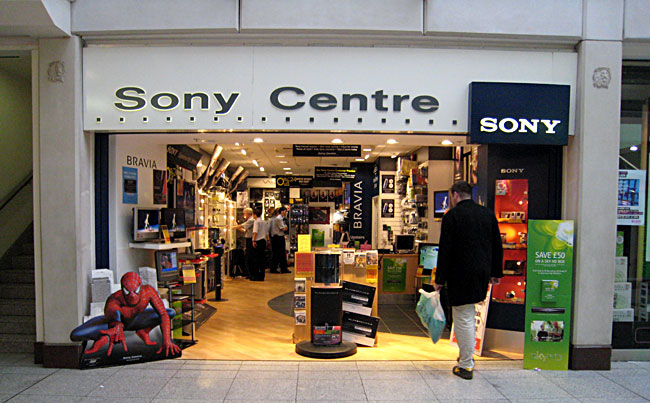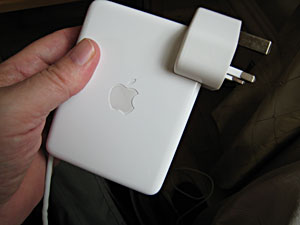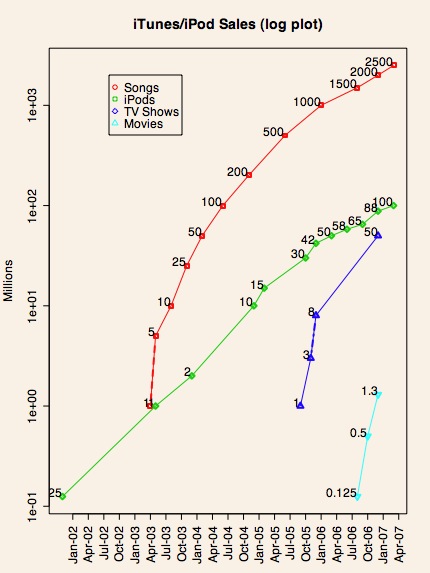Now available here.
Thanks to Brian for the link.

Now available here.
Thanks to Brian for the link.
… but it still comes with a battery that users cannot replace. This from TimesOnline:
News that Apple has upgraded the iPhone ahead of its US launch next Friday (June 29) helped add $2 billion (£1 billion) to the market value of the company in early trade today.
In a statement that seemed designed to counter mounting fears that the iPhone would be hampered by a lacklustre power supply, Apple said that the finished gadget will feature up to eight hours of talk time, six hours of internet use, seven hours of video playback or 24 hours of audio playback.
Previously Apple had specified five hours of talk time – though some technology commentators had put the figure as low as 40 minutes.
The device, already dubbed “The God Machine” by Apple aficionados, will also feature up to 250 hours – or more than 10 days – of standby time, the company claimed.
The news helped send the shares up more than 2 per cent in New York.
The company added that the entire top surface of the iPhone has been upgraded from plastic to optical-quality glass “to achieve a superior level of scratch resistance and optical clarity”.
Apple’s premium devices, like the iPhone, continue to push the boundaries of technology, offering sleek designs and advanced features. However, as with any high-tech gadget, they are not immune to the wear and tear that comes with daily use.
For those whose iPhones are out of warranty or experiencing issues, finding a reliable service center becomes crucial. A premium out-of-warranty Apple service center can provide expert repairs and maintenance, ensuring your device functions at its best. These centers are equipped with top-tier tools and genuine Apple parts to deliver the high-quality service that users expect.
When searching for a trusted service provider, look no further than https://www.celmetro.com. With a team of experienced technicians and a commitment to using only authentic components, they offer comprehensive repair solutions that restore your device to its original performance.
Whether it’s a cracked screen, battery issues, or any other concern, CelMetro ensures your iPhone receives the attention it deserves. Their quick turnaround and attention to detail make them an excellent choice for those looking to extend the lifespan of their Apple products.
Stock markets are such funny organisms. Deeply erratic. Like elderly maiden aunts.
Apple’s news release here. Good Morning Silicon Valley reports a survey which claims that 19 million Americans are ‘seriously considering’ buying an iPhone. I guess they’re also the people who believe in Intelligent Design.

Came on this — the first ‘integrated’ package for the Macintosh — when sorting stuff in my office. I couldn’t bear to throw it out. And although none of my current Macs has a drive that could read the disk, I still have my Mac Plus, which can.
Well, well. I’d been wondering about this, and now ArsTechnica confirms it…
With great power comes great responsibility, and apparently with DRM-free music comes files embedded with identifying information. Such is the situation with Apple’s new DRM-free music: songs sold without DRM still have a user’s full name and account e-mail embedded in them, which means that dropping that new DRM-free song on your favorite P2P network could come back to bite you.
We started examining the files this morning and noticed our names and e-mail addresses in the files, and we’ve found corroboration of the find at TUAW, as well. But there’s more to the story: Apple embeds your account information in all songs sold on the store, not just DRM-free songs. Previously it wasn’t much of a big deal, since no one could imagine users sharing encrypted, DRMed content. But now that DRM-free music from Apple is on the loose, the hidden data is more significant since it could theoretically be used to trace shared tunes back to the original owner. It must also be kept in mind that this kind of information could be spoofed.
Concerned users could convert selections to MP3, but there will be a generational loss in quality resulting from the transcoding. We also have to wonder: who is buying DRM-free music with the plans of slapping it up on a P2P share, anyway? It’s not like there aren’t dozens of other ways to get access to music without paying for it…
Brent Schendler wrote a snooty piece in Fortune About Apple TV, which he doesn’t think much of. He explains further in his blog…
He wrote the column, he says,
to point out that even Apple can bungle a product from time to time. Another thing I probably should have said in the column was that in a broader sense, flubbing is actually a good thing, because it shows that Apple is genuinely trying to raise the state of the art of consumer electronics. As the old Silicon Valley saying goes: “If you don’t launch a dud now and then, it means you aren’t trying hard enough.” Finally, I also wanted to show how even Apple can sometimes make the same kinds of mistakes that Microsoft does.
Mainly, however, with the launch of the much ballyhooed iPhone looming in June, I thought it was important to point out how Apple TV demonstrates that Steve Jobs, the ultimate control freak, is not in total control of all the production values of his new consumer electronics products; at least not as much as has been the case in the past with his computers and the first few generations of the iPod and iTunes. That’s not his fault, but instead is because Apple, as it ventures further afield, no longer “builds the whole widget” to the extent that it has in the past. It must rely on capricious movie studios and TV networks and record companies for content of course, and it increasingly will depend on stubborn telecom carriers for cellular and broadband connectivity and for marketing help.
Steve Jobs loves music, and the much celebrated iPod clearly was not the product of someone with a tin ear. “Elegant” really is the appropriate adjective to use to describe it, because every little nuance seemed right. But Apple TV makes you wonder if Jobs paid any attention at all during the birthing process. Or maybe it betrays how his well-known disdain for broadcast television might have left him with a blind spot when it comes to TV-related products. Or perhaps this is just what happens to a company when it develops the makings of a high-tech monopoly that it wants to preserve and extend, in this case the market for digital downloads. Speaking as a long-time Apple fan, I sure hope not.
Hilarious joint interview from D:5 conference. It’s a clumsily edited compilation, though. Jobs seems much more adept than Gates at this kind of thing. The whole interview is split into seven segments. Worth wading through the whole sequence if you have the time. Or you can read the transcript.
Randall Stross has a perceptive NYT piece about the difference between Apple’s retail stores and Sony’s:
Last Sunday, I set out to have a look for myself. I began at Sony’s flagship in San Francisco, at the Metreon Center, the shopping and entertainment complex. The mall was crowded, but Sony’s store, measuring an enormous 20,000 square feet, was all but deserted. The two uniformed members of the store security staff matched the number of customers I could see browsing the store’s wares.
Then I headed for the Stanford Shopping Center in Palo Alto, where I could see a Sony Style store compete almost directly across from an Apple retail store. The weather was gorgeous, drawing the usual weekend throng to the shopping center.
Sony’s mall store was long and large — 6,000 square feet — and filled with curvy panels and chirpy taglines like “My Style” on the walls and plush theater nooks. Here, too, the sales staff seemed to outnumber customers.
A group of five young salesmen and saleswomen who stood near the door when I entered were so engaged in a private, and apparently amusing, discussion that my imploring presence failed to draw anyone’s attention. The only other customers in the store were at the far other end, near the PlayStations. I suppose that the employees near me had become accustomed to busying themselves with their own entertainments.
A few yards away was the Apple store, which is one of Apple’s newer “mini” stores, introduced in 2004 and only about an eighth the size of Sony’s Stanford store. It was simplicity itself: a rectangular space with products lining the two sides, laptops placed on a small table, open space taking up most of the room, and, of course, the Genius Bar. The store was packed, yet the sales people were alert and attentive…

He’s right. There’s a Sony store in Cambridge (see above) and it generally seems pretty deserted. The photograph shows four staff and no customers. In contrast, I’ve never seen an Apple store that wasn’t packed. Among other things, there’s the fact that Apple provides what amounts to a free Internet cafe.
It’s strange to see the way the two companies have switched roles. Sony dominated the market for chic gadgets for decades (the Walkman, remember, was the iPod of its day). Now Sony has become, somehow, pathetic.

This is the power supply that came with my Apple MacBook Pro. It’s got the fancy magnetic connector at the other end, but the transformer unit itself is surprisingly large. In fact, it’s very carefully designed to make it impossible to plug it into any mains socket in any British institutional building, where the sockets are invariably in the wainscoting — as, for example, here (Downing College, Cambridge):

It fell to James Cridland to suggest the obvious workaround — to remove the three-pin plug and use a standard mains lead (the kind one uses to charge the batteries of many digital devices).

Obvious when you think about it — or rather when he suggested it. But it means lugging around another piece of wire. Sigh.
Wow! Interesting post by Blackfriars Marketing, a marketing consultancy run by Joe Butt and Carl Howe.
Today’s New York times ran [an] Apple ad … celebrating 100 million iPods sold. With that milestone achieved, I thought it might be interesting to analyze the last five years of iPod and iTunes growth.
In case anyone believes that selling 100 million iPods in five years is no big deal, here’s a bit of history. In 1945, there were 7,000 televisions in the US. By 1949, that number had grown to 1 million, and it hit 10 million just two years later in 1952. But it took more than 30 years for the number of televisions sold to exceed 100 million. Apple achieved that same 100 million mark with iPods in just five years.
Now those 100 million iPods are a big deal for Apple’s bottom line, but iTunes music has actually outstripped iPod growth. Blackfriars got involved in a little disagreement last year with an old Forrester colleague about iTunes sales. Based upon some of the data he had, he claimed that it appeared iTunes sales were slowing. I used the data I had to prove that he’d picked a particularly unfortunate sample to examine, namely the period between January and September, when fewer songs are purchased than in the big holiday season. But still, there was a lot of Web ink spilled discussing the point.
I think we can now lay that argument to rest once and for all. The folks over at Macsimum News picked up a little-noted quote from Steve Jobs saying that iTunes just passed the 2.5 billion song mark. Now for those of you keeping score at home, that means that iTunes is now selling a billion songs about every six months. But wait, there’s more! According to our figures, iPod sales passed the 100 million iPod mark in March, and TV shows passed the 50 million shows sold mark as well. Add onto that the 1.3 million feature length movies that have been sold to date, and well, I’d say you have quite a fast-growing business…
The author has made a logarithmic graph of various aspects of Apple media-related sales. (Remember that exponential growth shows up as a straight line on a log graph.)

The Blackfriars commentary continues:
Now if you ask me, the really interesting part about this graph is the fact that iPod sales appear to be continuing their exponential climb into the stratosphere. That’s important because it drives Apple’s earnings report, which we’ll hear more about later this month. But don’t ignore those TV shows or movies at the bottom. They’re on a very steep growth curve themselves — and there are a lot of new Apple TVs that are going to need feeding with content this year.
So what does the future hold for iPods and iTunes? While music is what made the iPod and will continue to be the major driving force behind Apple’s iPod thrust, Apple is trailblazing growth in digital movies and TV shows in a way similar to what it did in music in 2002. Remember Apple’s announcement that in the first week or so of movie sales, it sold 125,000 movies? Well, today’s Boston Globe reported the first month’s sales from Wal-mart’s online movie store were a whopping 3,000 movies. If we were to graph that on the log scale graph above, we’d need to add another decade of graph below where Apple numbers are just to see the Wal-mart sales. By all public measures available so far, iTunes is well on the way to repeating its domination of digital music in digital TV and movies. After all, once you’ve bested the largest American retailer, the sky is the limit.
This morning’s Observer column…
DRM was in the news because of EMI’s unexpected announcement that, starting next month, it will sell its stuff on iTunes in two flavours: one is the standard, DRM-crippled variety; the other a premium version with higher audio quality and without DRM.
The announcement came as a bolt from the blue, though I suppose that if anyone had spotted Apple’s CEO, Steve Jobs, going through Heathrow they might have suspected that something big was afoot. Mr Jobs does not normally descend to earth for anything as mundane as another company’s press conferences. But there he was on the platform, alongside EMI’s chief executive, Eric Nicoli. Selling digital music DRM-free is the right step forward for the music industry, intoned Steve. EMI has been a great partner for iTunes and is once again leading the industry as the first major music company to offer its entire digital catalogue DRM-free…